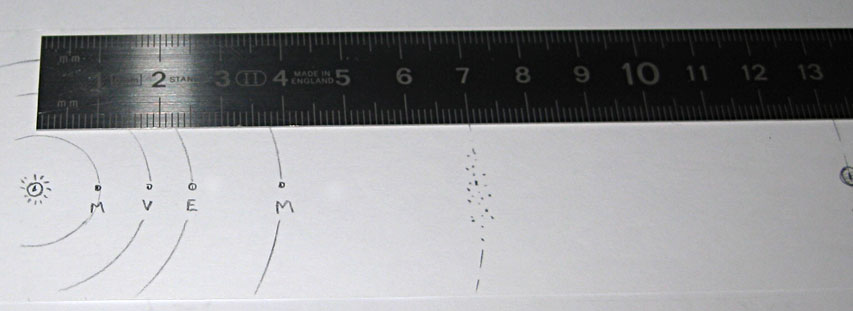What?
How proud should we humans be of our powers?
Let's first look at the size of stuff around us.
en
How proud should we humans be of our powers?
Let's first look at the size of stuff around us.
Let's for a moment assume that Pluto is still the furthest planet (or whatever it is now called) in the Solar system. Let's draw a model on a piece of paper, whereby the radius of the orbit of Pluto would be 1 metre. This is what it would look like:

With the Sun set at the left, Mercury would be at 10mm, Venus at 18mm, our Earth would be 25mm from the Sun, Mars 39, then there is the asteroid belt and just at the right of the image you can spot Jupiter. Saturn, Uranus and Neptune are not in the image, and Pluto would be at 1000mm or 1 metre away of course.
But could you see anything on that scale? No, just the Sun would be barely visible to the naked eye: it would be a round speck 0.2mm wide, like a quite small grain of salt! For everything else, including Jupiter, you would need a magnifying glass.
Now, where would the nearest star be? It is at over 4 lightyears away, and on the scale that we chose, it would be 7km from where we sit!
Think of it: in a radius of 7 km around our model, in all directions, there would be nothing notable whatever! On our chosen scale, that nearest star is of course also just a small grain of salt, nothing more.
Yet we can see the light of that tiny grain at 7km with the naked eye!
The universe is very empty. You should not forget that the stars around us are in the Galaxy, a pretty crowded place. It is even more empty between galaxies!
Despite these distances, we humans pride ourselves on our ability to go into space. We talk of astronauts, even cosmonauts. It is true that humans have been to the Moon. How far is the Moon on our diagram above? About 6.5 hundredths of a mm from the dot representing the Earth. That is about the width of a (thin) hair.
We have not been any further away ever. Now let's see where the International Space Station — ISS — is.
I have a globe:

Its diameter is 50cm. That's pretty big as globes go. But a model ISS on the same scale would not be able to orbit my globe, because it would crash into the arm:

Its orbit would pass about where the little red dot is.
That's how powerful humans are in space travel! I think we are fairly well stuck on this planet for quite a while, and we should take good care of it, because we are not going anywhere anytime soon.
Unless miracles in technology occur such as the discovery of hyperspace travel or the development of Star Trek's warp factor 8 drives. It is not excluded, but I would not bet on it yet.